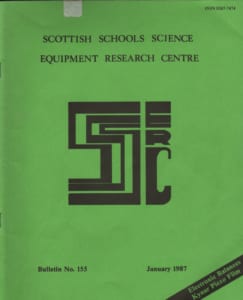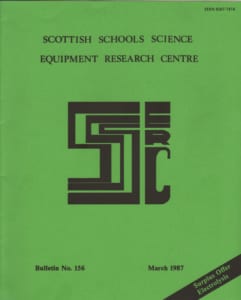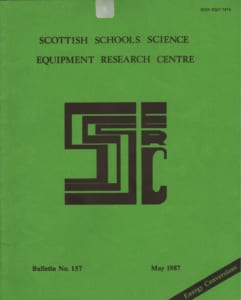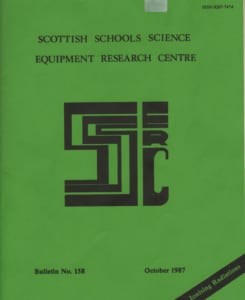The page numbers refer to the pages in the pdf. (The numbers in brackets are those given in the actual bulletin)
3(1) Opinion
In pursuit of the end of the rainbow
3(1) Introduction
ASE Scottish Region Annual Meeting, Cost Index, Ross & Lamont
4(2) Safety Note – Heat resistant cable for soldering irons
there is a chance that the hot tip will come into contact with the lead and burn through the insulation.
4(2) Safety Note – Sulphur dioxide canisters
How to deal with corrosion.
5(3) Biology Notes – Practical investigations
5(3) Biology Notes – Sizing cells
We were sent recently an idea on measuring plant cells.
6(4) Biology Notes – Biotechnology news
The National Centre for School Biotechnology in Reading has published the first edition of its “Newsletter”
7(5) Electronic balances – a review
An article on weighing requirements in Scottish school science courses and a review of the models currently on the market.
19(17) Interfacing software for electronic balances – a review
Software packages for interfacing four popular makes of balance to the BBC micro’ were examined. However only three are reported on here because the fourth package gave much trouble.
24(22) Kynar Piezo Film – a novel transducer
Kynar Piezo Film is a new material which can be used for many types of transducer. Its piezo-electric property will convert a mechanical force into an electrical signal.
26(24) Force-time plots and measurement of impulse
The force-time transient exerted on a ball as it hits a surface can be investigated by letting the ball drop on Kynar Piezo Film.
34(32) Measurement of long wave infra-red radiation
Kynar Piezo Film is exceedingly sensitive to changes in temperature; it behaves as a reliable detector of long wave infra red radiation and can be used for quantitative measurement.
36(34) Surplus equipment offers
37(35) Trade News
Power supplies for electronics
3(1) Opinion
On learning outcomes
3(1) Introduction
Easter closure, Big bids from little acorns
4(2) Safety Note – AIDS and school science
The new Scottish Office publication, “AIDS: Guidance for Educational Establishments in Scotland”. be available in every Scottish school and college. We think it gives an excellent, balanced overview.
5(3) “Science teacher fined”
Teacher fined after explosion reducing copper oxide with hydrogen.
6(4) Biology Note – sizing cells – a follow up
In Bulletin 155 we described an idea for a pupil investigation and set a simple problem. this was to use basic techniques in microscopy to estimate the average length and width of onion epidermal cells. We hinted at some solutions and promised to give more detail in this issue.
7(5) Chemistry Note – electrolysis
Lead electrodes have an advantage over the commonly used graphite electrodes in that the expected oxygen is indeed formed at the anode. Methods of making these and fitting them into cells of several designs are described.
12(10) Physics Note – to show that ordinary white light has an ultra violet component
If using an ordinary, broadband, white light source and conventional optics it is highly probable that the radiation coming from the source and transmitted through the optics will have a near ultra violet component. We have recently tested this hypothesisand have found a simple means of demonstrating that this is so.
13(11) Resolution, and the human senses
The premise is that mans’ senses of seeing, hearing and feeling are logarithmic in nature, and that in general man can just distinguish between fractional differences of around 10%. This article is an adaptation of an idea seen in ‘The Physics Teacher’
13(11) Graphical symbols
The British Standards Institution (BSI) have recently revised their special publication on graphical symbols.
14(12) Thermistor circuits
We are having another look at the thermistor bridge from Bulletin 150 because we think it is an extremely useful little circuit.
15(13) Surplus equipment offers
The page numbers refer to the pages in the pdf. (The numbers in brackets are those given in the actual bulletin)
3(1) Editorial
Learning outcomes
4(2) Introduction
One short of a full load, energy conversions, Saturday morning closures, Comment, No Comment (Science Education)
6(4) Resource News
‘shooting your Beeb, Schools Affiliation Scheme, Salters’ Institute Awards
6(24) AIDS addenda
The Laboratory Safeguards Committee of the Association for Science Education (ASE) has published its own note in “Education in Science”
6(24) Disposable toothbrushes
Possible use of disposable toothbrushes and a supplier.
7(5) HSE publications
Two new publications which should be of direct interest to science advisers and safety officers and may prove useful to teachers as background material:
8(6) ‘National Grid’ experiments
HSE in Scotland has recently sent a circular to Scottish EAs with warnings and conditions relating to such demonstrations.
9(7) Biology Note – Zany energy conversions
An energy conversion series, unusual in a biological context is described, viz.: chemical energy – light – electricity – kinetic energy.
12(10) Chemistry Note – Peanut power – letting off steam
If all we need is a simple experience of the relatively large amounts of energy stored within a thing like a peanut then the following, more dramatic, illustration is a good one.
10(8) Chemistry Note – On fruit and fuel (light, luminescence and lemons)
Energy as a permeating theme of chemistry is briefly discussed. Three specific, and somewhat unusual, practical illustrations of energy conversions are described. (Chemiluminescence, Lemon Cell, Electrolytic fuel call)
17(15) Physics Note – Hydro power
Two designs of model overshot water wheels are outlined. Two applications, one in generating electricity, the other in driving a pump, are described. A calculation of the efficiency in the first application is provided.
21(19) Trade News
Harris drop carriage charges, Get a ‘walkover’
21(19) Announcements
New Vela centre, New Napier degree, Biotechnology in the curriculum
The page numbers refer to the pages in the pdf. (The numbers in brackets are those given in the actual bulletin)
3(1) Opinion
Ionising radiations and the management of risk
4(2) Editorial
Hiccups, hiatus & hernias, Jam tomorrow?
5(3) Introduction
Double jeopardy, Saturday mornings, Cost index, Surplus offers: conditions of sale, No Comment, Comment
6(4) CLEAPSE Guides
We have recently received the following new or revised publications from our sister organisation CLEAPSE School Science Service.
6(4) VELA Booklet
Adrian Watt, of Edinburgh Academy and the Scottish VELA Users’ Group, has produced a small volume on “Demonstrations & Experiments using VELA”.
7(9) Ionising radiations – The element of risk
We have recently estimated by calculations the probable whole body doses resulting from typical practical sessions with school-type sources. These reveal the somewhat comforting news that likely doses are extremely small
10(8) Bunsen flame profiles
The temperature profiles flame are examined by the listed in ascending order of sophistication.
15(13) Amplifier for type K thermocouple
The type K thermocouple described in the Bunsen profile article has a sensitivity of about 40,p.V/°C. By applying the signal to an amplifier with a gain of25 you can boost the sensitivity to 1 mV/°C
16(14) Radioactive decay experiments using protactinium-234
The protactinium generator should be used as a substitute for the now prohibited Thoron generator for studying radioactive decay.
19(17) h.t. transmission lines
We have for some time been concerned that many teachers demonstrate the working of the National Grid at voltages which are potentially lethal.
21(19) Ring main models
A ring main model should show that if appliances are wired in parallel there can be an appreciable voltage drop across cables which transmit power from appliance to appliance. When the ring is made any voltage drop in cables becomes insignificant.
13(21) Jupiter
The present position and brilliance of’ Jupiter provide a good opportunity to start off pupils viewing the night sky.
24(22) Surplus Equipment Offers







